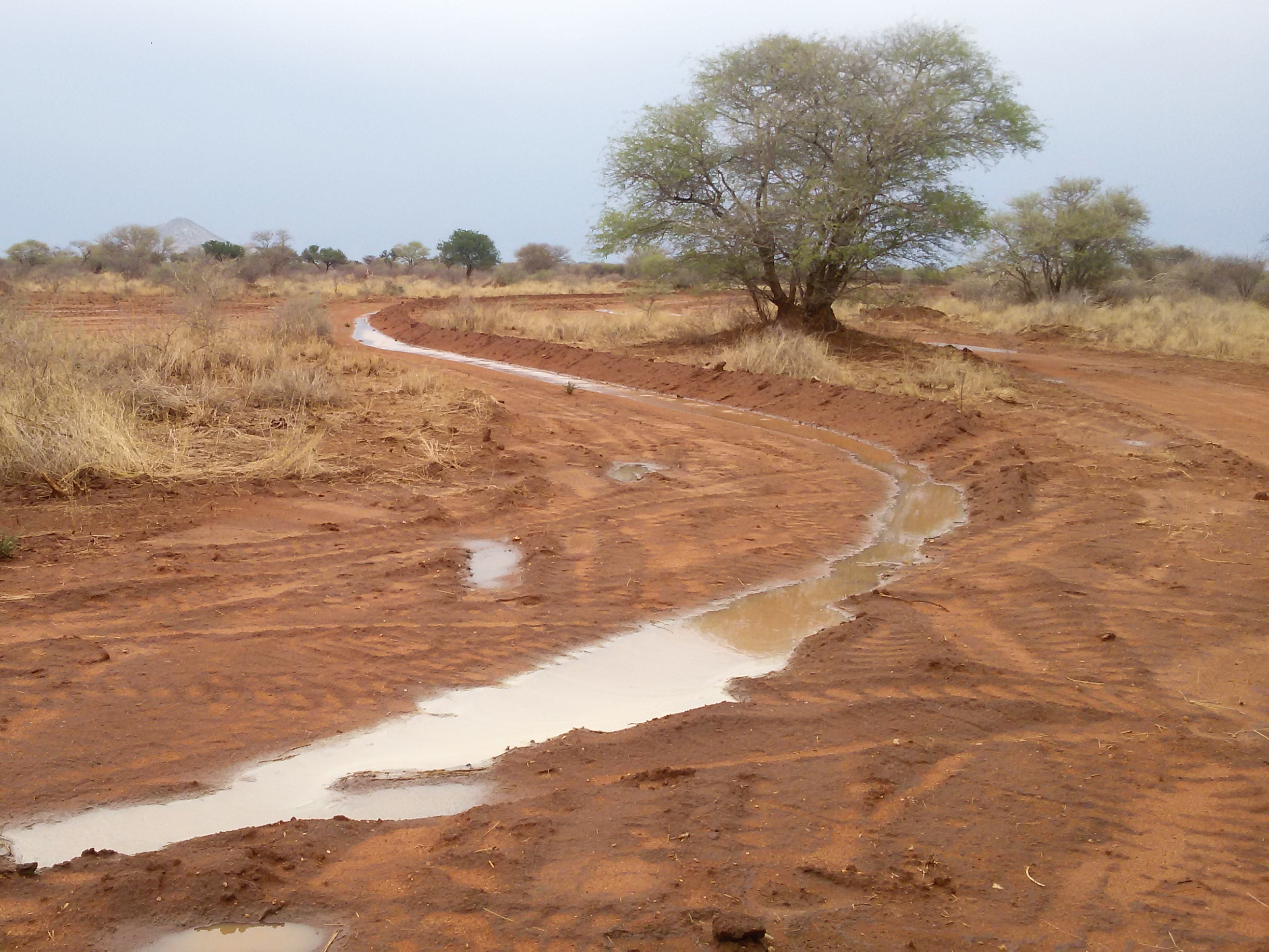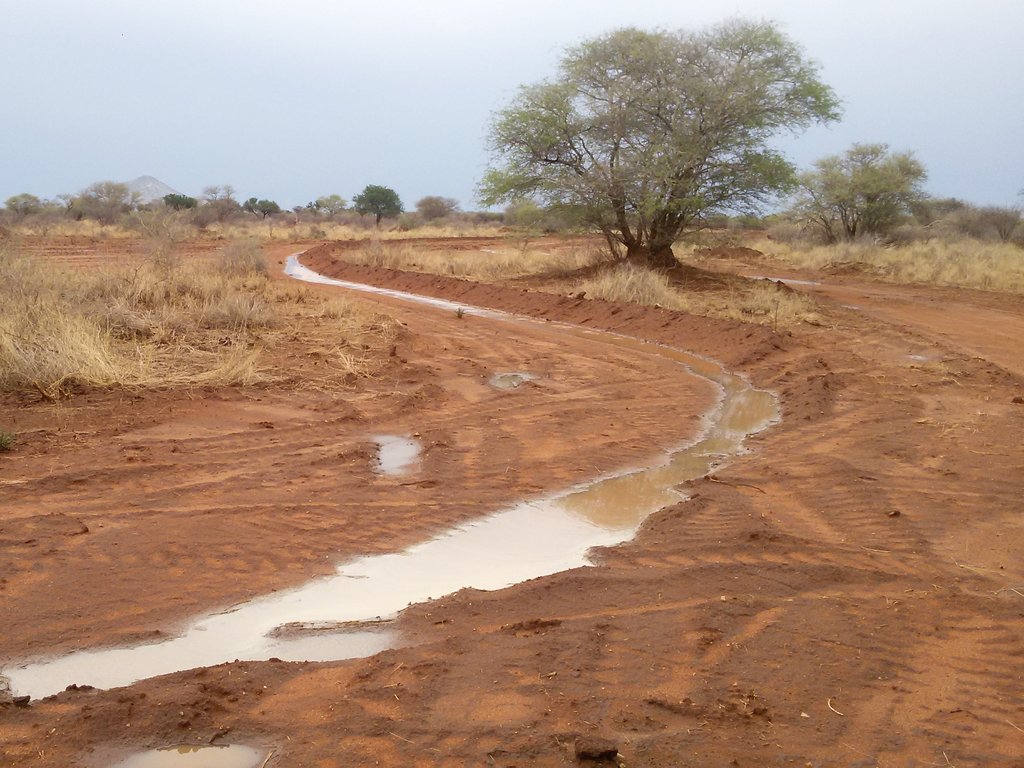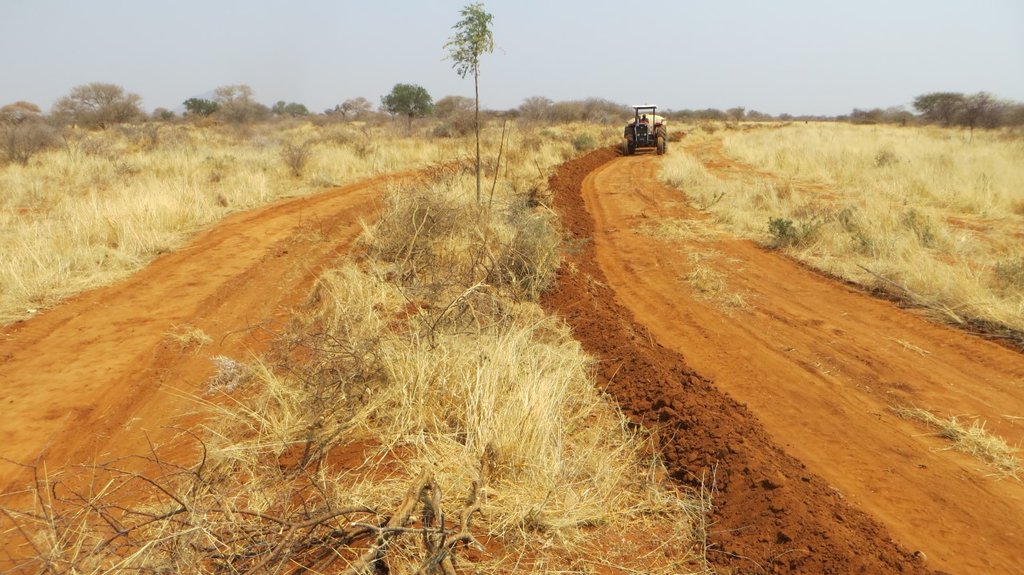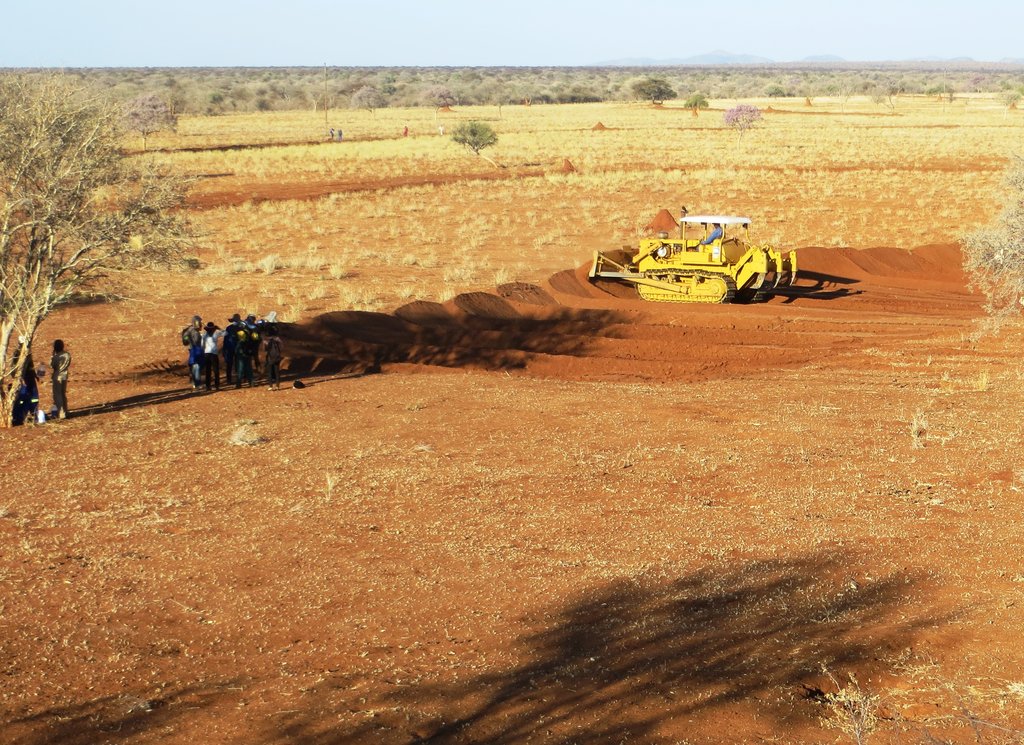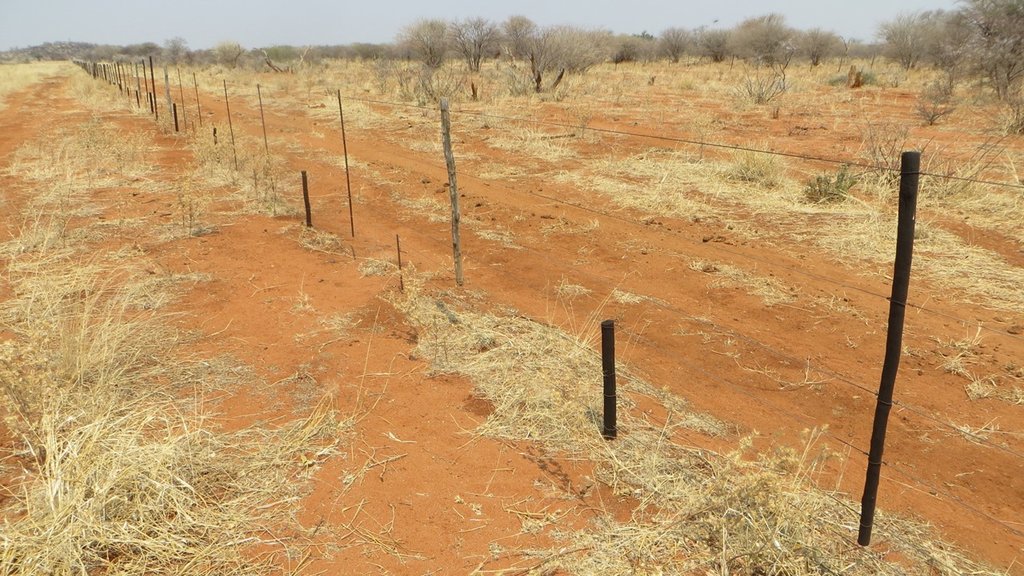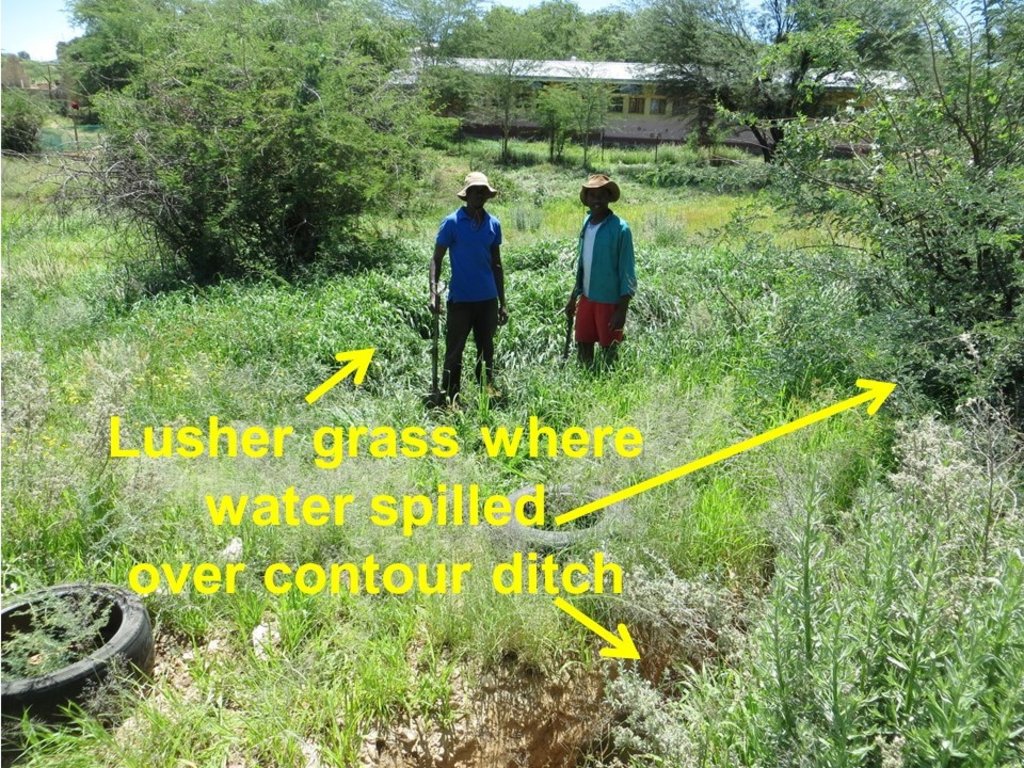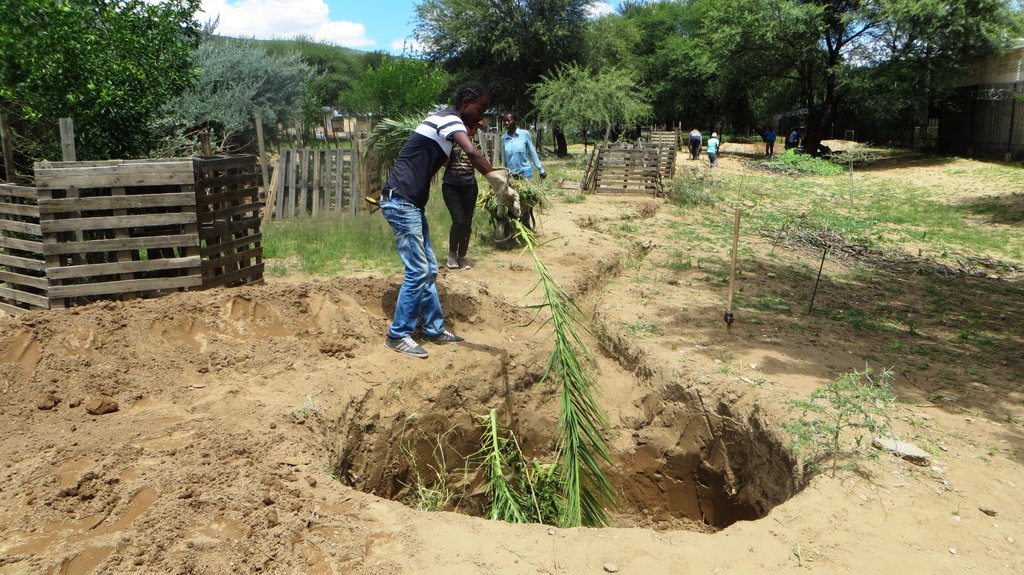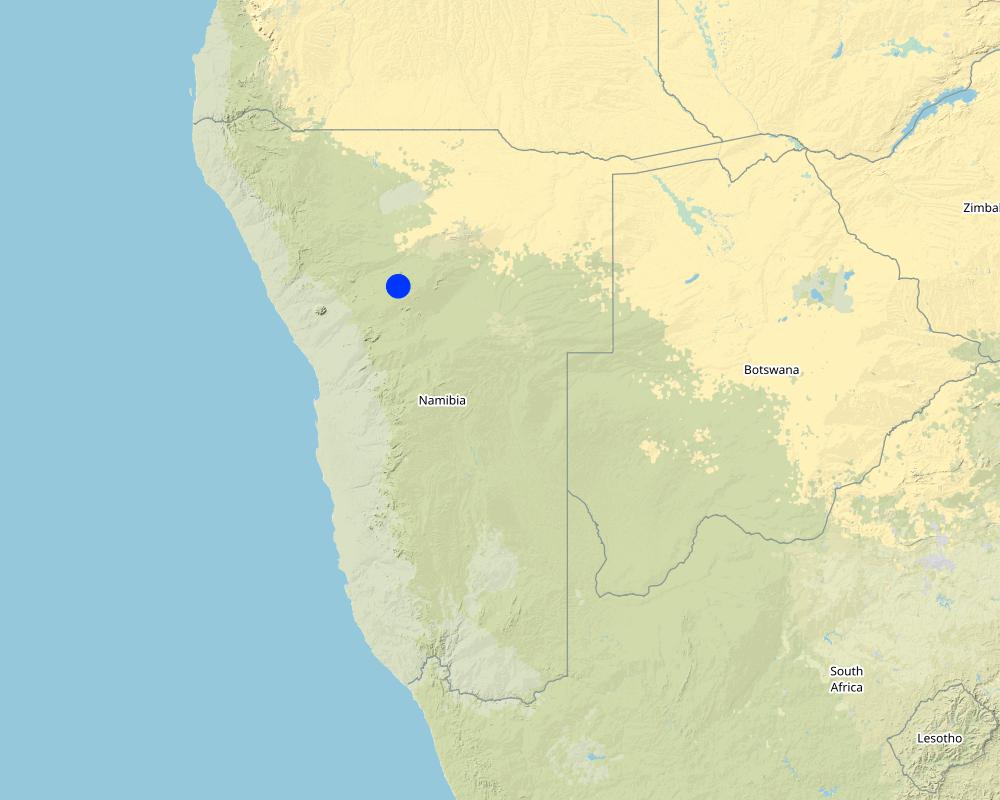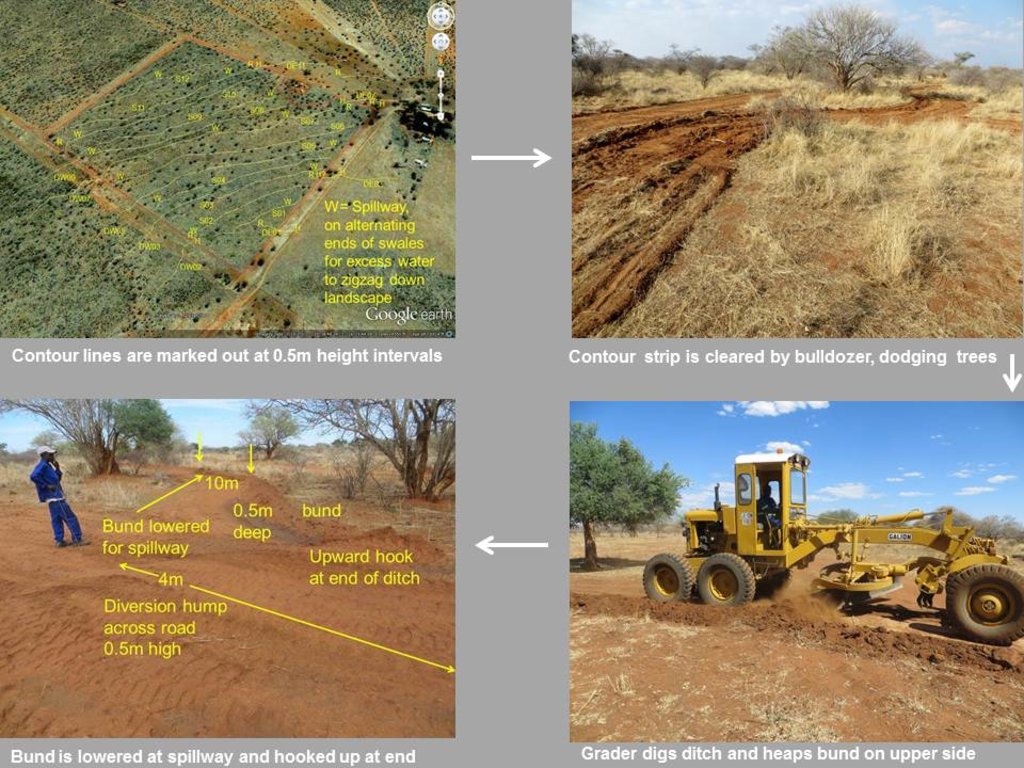Infiltration ditches and ponding banks [纳米比亚]
- 创建:
- 更新:
- 编制者: Ibo Zimmermann
- 编辑者: –
- 审查者: Alexandra Gavilano, Rima Mekdaschi Studer, Joana Eichenberger
Ovala
technologies_2989 - 纳米比亚
查看章节
全部展开 全部收起1. 一般信息
1.2 参与该技术评估和文件编制的资源人员和机构的联系方式
关键资源人
土地使用者:
Kahl Uwe
Farm Middelplaats
纳米比亚
SLM专业人员:
SLM专业人员:
Pringle Hugh
Ecosystem Management Understanding
澳大利亚
有助于对技术进行记录/评估的项目名称(如相关)
Southern African Science Service Centre for climate change and Adaptive Land management (SASSCAL)有助于对技术进行记录/评估的项目名称(如相关)
Book project: Guidelines to Rangeland Management in Sub-Saharan Africa (Rangeland Management)有助于对技术进行记录/评估的机构名称(如相关)
Namibia University of Science and Technology ( NUST) - 纳米比亚有助于对技术进行记录/评估的机构名称(如相关)
German Federal Ministry of Education and Research (BMBF) - 德国1.3 关于使用通过WOCAT记录的数据的条件
编制者和关键资源人员接受有关使用通过WOCAT记录数据的条件。:
是
1.4 所述技术的可持续性声明
这里所描述的技术在土地退化方面是否存在问题,导致无法被认为是一种可持续的土地管理技术?:
否
1.5 参考关于SLM方法(使用WOCAT记录的SLM方法)的调查问卷

Arrangements to convert degraded rangeland into fruitful landscape [纳米比亚]
Making arrangements between a commercial farmer and agriculture students to raise the productivity of rangeland - through managing runoff to grow multipurpose trees and bushes.
- 编制者: Ibo Zimmermann
2. SLM技术的说明
2.1 技术简介
技术定义:
Construction of contour ditches and ponding banks/ bunds to trap rainwater for infiltration. Improved growth of plants and replenishment of groundwater is promoted, while safely discharging excess water to avoid erosion. Integrated with other technologies that treat the root causes of rangeland degradation - rather than a stand-alone technology.
2.2 技术的详细说明
说明:
The technology can be applied in rangeland: (a) where rainfall runoff occurs, (b) where the soil is deep enough to dig contour ditches and construct ponding banks, (c) where there is a low slope over a wide enough area for safe discharge of overflow during intense rain, (d) where valuable plants can benefit from the extra infiltrated rainwater, (e) where the costs of earthmoving can be rapidly recovered through sale of extra production and, very importantly, (f) where the root causes of rangeland degradation have been addressed, usually through management of grazing and fires.
In the appropriate area, contour lines are marked out by laser or dumpy level - or mapped by drone. Where bush is dense, it may be necessary to clear narrow contour strips, leaving larger trees in place. Ditches are dug up to 50cm deep by mechanised grader or backhoe (a digger attached to a tractor), or manually by pick and spade. The soil should first ideally be ripped where the bund is formed, to ensure a firm foundation. To stabilise the bund, it should be compacted, and creeping (stoloniferous) herbaceous plants encouraged to colonise it. When ditches are full, water is discharged through spillways within the bund. These spillways are formed by lowering the bund to about half its height (i.e. 25 cm) for a distance of 10 metres. Water overtops the spillways and flows across the soil surface to the next bund in the sequence. Spillways are set near alternating ends of shorter ditches for water to zigzag its way down through the landscape, but along longer ditches the spillways are set approximately 200 metres apart. There are other configurations, including one where excess runoff flows around the end of the bund and along another channel constructed immediately below the bund. It can then spill out of this channel, evenly over the soil surface below. Where bunds meet roads or tracks, a hump is made in the road to prevent water crossing and causing damage but instead channelling the road runoff into contour ditches.
Since the channel is never exactly on the contour, water starts to flow over the lowest section. This results in self-reinforcement over time because herbaceous plants establish more densely at that point, resulting in more sediment being trapped there. To avoid spillage around each end of the ditch, the bund is shaped to form a short upslope wingwall. Organic material can be placed in the ditch, or in larger sediment traps within the ditch, to improve nutrient cycling.
Infiltration ditches were constructed at vertical intervals of 0.5 m on a 30 ha, densely bushed portion of the Middleplaats farm. Trees were planted below the ditches to grow into a “fruitful landscape”. Species included broad canopy trees such as Faidherbia albida and Acacia erioloba, shorter thornless trees for “chop and drop” mulching, such as Peltophorum africanum and Bolusanthus speciosus, and fruit bearing trees, such as Sclerocarya birrea and Berchemia discolor, or trees with edible leaves, such as Moringa oleifera. Tree seedlings were raised in a nursery. Fencing around the 30ha had to be strengthened to protect the seedlings from oryx. It was also necessary to water the seedlings for one to two years until well established. Ponded water encourages natural growth of herbaceous plants, and to encourage this some grasses were transplanted there.
2.3 技术照片
2.4 技术视频
注释、简短说明:
https://www.youtube.com/watch?v=6C4V_Cib8ts
Only a short section in the film from 18m07s to 19m15s
日期:
08/04/2015
位置:
Farm Middelplaats and KAYEC campus, both in Namibia
摄影师的名字:
Andrew Botelle
2.5 已应用该技术的、本评估所涵盖的国家/地区/地点
国家:
纳米比亚
区域/州/省:
Otjozondjupa and Khomas Retions
具体说明该技术的分布:
- 均匀地分布在一个区域
如果不知道精确的区域,请注明大致覆盖的区域:
- 0.1-1 平方千米
Map
×2.6 实施日期
注明实施年份:
2014
2.7 技术介绍
详细说明该技术是如何引入的:
- 通过项目/外部干预
注释(项目类型等):
Projects involving students
3. SLM技术的分类
3.1 该技术的主要目的
- 改良生产
- 减少、预防、恢复土地退化
- 保持/提高生物多样性
- 创造有益的经济影响
3.2 应用该技术的当前土地利用类型

牧场
粗放式放牧:
- 经营牧场
动物类型:
- 牛 - 非奶牛牛肉
注释:
Main animal species and products: Beef cattle and game animals
Number of growing seasons per year: 1
Livestock density: 10ha/LSU averaged out over time and not continuous
3.4 供水
该技术所应用土地的供水:
- 雨养
注释:
Except for Initial watering of planted tree seedlings, which was necessitated by drought
3.5 该技术所属的SLM组
- 农业林学
- 畜牧业和牧场管理
- 集水
3.6 包含该技术的可持续土地管理措施

植物措施
- V1:乔木和灌木覆盖层
- V2:草和多年生草本植物
- V3:植被的清理

结构措施
- S2:堤、岸
- S4:平沟、坑

管理措施
- M2:改变管理/强度级别
- M5:物种组成的控制/变化
3.7 该技术强调的主要土地退化类型

土壤水蚀
- Wt:表土流失/地表侵蚀
- Wg:冲沟侵蚀/沟蚀

水质恶化
- Hg:地下水/含水层水位的变化
3.8 防止、减少或恢复土地退化
具体数量名该技术与土地退化有关的目标:
- 防止土地退化
- 修复/恢复严重退化的土地
4. 技术规范、实施活动、投入和成本
4.1 该技术的技术图纸
技术规范(与技术图纸相关):
Contour strips were cleared by bulldozer at 0.5m vertical intervals on land with a gradient of approximately 1.0%. A line was ripped approximately 0.6m deep, over which soil was heaped to form a bund by a grader while excavating a ditch on its upper side to hold rainwater at a depth of approximately 0.5m. Spillways were created by lowering a 10m length of the bund. Spillways were staggered between ditches to zig-zag the spilled water slowly through the landscape. A variety of tree seedlings were planted alongside the structures to make use of the extra water, providing tall canopies, “chop-and-drop” mulching, and edible leaves or fruits.
作者:
Ibo Zimmermann
日期:
21/07/2017
4.2 有关投入和成本计算的一般信息
具体说明成本和投入是如何计算的:
- 每个技术区域
注明尺寸和面积单位:
30ha (contour ditches only)
其它/国家货币(具体说明):
NAD
注明雇用劳工的每日平均工资成本:
72 NAD
4.3 技术建立活动
| 活动 | 时间(季度) | |
|---|---|---|
| 1. | Marking of contour lines | Dry season |
| 2. | Clearing of bush strips along contour | Dry season |
| 3. | Ripping along contour | Dry season |
| 4. | Digging ditch and heaping bund over ripline | Start of rains |
| 5. | Raising tree seedlings in nursery | Mostly dry season |
| 6. | Planting tree seedlings below ditches | Rainy season |
| 7. | Watering tree seedlings | Dry season |
| 8. | Strengthening fence around landscape to exclude oryx | When needed |
4.4 技术建立所需要的费用和投入
| 对投入进行具体说明 | 单位 | 数量 | 单位成本 | 每项投入的总成本 | 土地使用者承担的成本% | |
|---|---|---|---|---|---|---|
| 劳动力 | Marking of contour lines | Person days | 6.0 | 72.0 | 432.0 | 100.0 |
| 劳动力 | Raising tree seedlings in nursery | Person days | 20.0 | 72.0 | 1440.0 | 100.0 |
| 劳动力 | Planting tree seedlings below ditches | Person days | 10.0 | 72.0 | 720.0 | 100.0 |
| 劳动力 | Watering every 10 days in first year, except after rain | Person days | 150.0 | 72.0 | 10800.0 | 100.0 |
| 设备 | Strengthening fence to exclude oryx (Labour) | Person days | 100.0 | 72.0 | 7200.0 | 100.0 |
| 设备 | Bulldozer to clear strips and rip | Bulldozer hours | 89.0 | 850.0 | 75650.0 | 100.0 |
| 设备 | Grader to dig ditches and heap bunds | Grader hours | 35.0 | 650.0 | 22750.0 | 100.0 |
| 设备 | Diesel for bulldozer and grader | Litres | 1000.0 | 12.0 | 12000.0 | 100.0 |
| 设备 | Tractor & 7000 lt water trailer every 10 days in first year, except after rain | Tractor days | 30.0 | 1250.0 | 37500.0 | 100.0 |
| 植物材料 | 500 Plastic bags / seeds with soil to raise seedllngs | Filled growing bags | 500.0 | 4.0 | 2000.0 | 100.0 |
| 施工材料 | Fencing wire and posts to strengthen fence around fruitful landscape | km of fencing | 3.0 | 2200.0 | 6600.0 | 100.0 |
| 技术建立所需总成本 | 177092.0 | |||||
| 技术建立总成本,美元 | 177092.0 | |||||
4.5 维护/经常性活动
| 活动 | 时间/频率 | |
|---|---|---|
| 1. | Maintenance of ditches and bunds by grader | Rainy season |
4.6 维护/经常性活动所需要的费用和投入(每年)
| 对投入进行具体说明 | 单位 | 数量 | 单位成本 | 每项投入的总成本 | 土地使用者承担的成本% | |
|---|---|---|---|---|---|---|
| 设备 | Grader cost to maintain the swales every 3 – 4 years | Grader hours | 8.0 | 700.0 | 5600.0 | 100.0 |
| 技术维护所需总成本 | 5600.0 | |||||
| 技术维护总成本,美元 | 5600.0 | |||||
4.7 影响成本的最重要因素
描述影响成本的最决定性因素:
High cost of hiring or operating earthmoving machinery.
5. 自然和人文环境
5.1 气候
年降雨量
- < 250毫米
- 251-500毫米
- 501-750毫米
- 751-1,000毫米
- 1,001-1,500毫米
- 1,501-2,000毫米
- 2,001-3,000毫米
- 3,001-4,000毫米
- > 4,000毫米
有关降雨的规范/注释:
A single summer rainfall period over approximately four months per year
注明所考虑的参考气象站名称:
Otjiwarongo
农业气候带
- 半干旱
5.2 地形
平均坡度:
- 水平(0-2%)
- 缓降(3-5%)
- 平缓(6-10%)
- 滚坡(11-15%)
- 崎岖(16-30%)
- 陡峭(31-60%)
- 非常陡峭(>60%)
地形:
- 高原/平原
- 山脊
- 山坡
- 山地斜坡
- 麓坡
- 谷底
垂直分布带:
- 0-100 m a.s.l.
- 101-500 m a.s.l.
- 501-1,000 m a.s.l.
- 1,001-1,500 m a.s.l.
- 1,501-2,000 m a.s.l.
- 2,001-2,500 m a.s.l.
- 2,501-3,000 m a.s.l.
- 3,001-4,000 m a.s.l.
- > 4,000 m a.s.l.
说明该技术是否专门应用于:
- 不相关
关于地形的注释和进一步规范:
Scattered rocky outcrops
5.3 土壤
平均土层深度:
- 非常浅(0-20厘米)
- 浅(21-50厘米)
- 中等深度(51-80厘米)
- 深(81-120厘米)
- 非常深(> 120厘米)
土壤质地(表土):
- 粗粒/轻(砂质)
土壤质地(地表以下> 20厘米):
- 粗粒/轻(砂质)
表土有机质:
- 低(<1%)
如有可能,附上完整的土壤描述或具体说明可用的信息,例如土壤类型、土壤酸碱度、阳离子交换能力、氮、盐度等。:
A calcrete layer is occasionally exposed at the soil surfacce
5.4 水资源可用性和质量
地下水位表:
5-50米
地表水的可用性:
匮乏/没有
水质(未处理):
不良饮用水(需要处理)
水的盐度有问题吗?:
是
具体说明:
The water is only slightly brackish
该区域正在发生洪水吗?:
否
5.5 生物多样性
物种多样性:
- 中等
栖息地多样性:
- 中等
5.6 应用该技术的土地使用者的特征
定栖或游牧:
- 定栖的
生产系统的市场定位:
- 商业/市场
非农收入:
- 收入的10-50%
相对财富水平:
- 平均水平
个人或集体:
- 个人/家庭
机械化水平:
- 手工作业
- 机械化/电动
性别:
- 女人
- 男人
土地使用者的年龄:
- 中年人
5.7 应用该技术的土地使用者使用的平均土地面积
- < 0.5 公顷
- 0.5-1 公顷
- 1-2 公顷
- 2-5公顷
- 5-15公顷
- 15-50公顷
- 50-100公顷
- 100-500公顷
- 500-1,000公顷
- 1,000-10,000公顷
- > 10,000公顷
这被认为是小规模、中规模还是大规模的(参照当地实际情况)?:
- 大规模的
5.8 土地所有权、土地使用权和水使用权
土地所有权:
- 个人,有命名
土地使用权:
- 个人
用水权:
- 个人
5.9 进入服务和基础设施的通道
健康:
- 贫瘠
- 适度的
- 好
教育:
- 贫瘠
- 适度的
- 好
技术援助:
- 贫瘠
- 适度的
- 好
就业(例如非农):
- 贫瘠
- 适度的
- 好
市场:
- 贫瘠
- 适度的
- 好
能源:
- 贫瘠
- 适度的
- 好
道路和交通:
- 贫瘠
- 适度的
- 好
饮用水和卫生设施:
- 贫瘠
- 适度的
- 好
金融服务:
- 贫瘠
- 适度的
- 好
6. 影响和结论性说明
6.1 该技术的现场影响
社会经济效应
生产
饲料生产
注释/具体说明:
Mainly Moringa oleifera
饲料质量
注释/具体说明:
Moringa leaves
畜牧生产
注释/具体说明:
Moringa heavily browsed
非木材林业生产
注释/具体说明:
Still saplings
产品多样性
注释/具体说明:
Moringa leaves and fruits of other species could be harvested
水资源可用性和质量
家畜用水的可用性
注释/具体说明:
Livestock need less water after feeding on lush forage
收入和成本
农业投入费用
注释/具体说明:
High initial cost of earthmoving
收入来源的多样性
注释/具体说明:
Potential from Moringa
工作量
注释/具体说明:
To water saplings
社会文化影响
食品安全/自给自足
注释/具体说明:
Nutritious Moringa leaves may be added to diets
健康状况
注释/具体说明:
If nutritious Moringa leaves are eaten
SLM/土地退化知识
注释/具体说明:
Learning from action research
生态影响
水循环/径流
地表径流
注释/具体说明:
Slowed, spread and infiltrated by ditches and ponds
地下水位/含水层
注释/具体说明:
From improved infiltration
土壤
土壤水分
注释/具体说明:
Near ditches and banks
土壤覆盖层
注释/具体说明:
In ditches and ponds
养分循环/补给
注释/具体说明:
Below ditches and ponds
土壤有机物/地下C
注释/具体说明:
Through tree and grass roots
生物多样性:植被、动物
植被覆盖
注释/具体说明:
In ditches and ponds
生物量/地上C
注释/具体说明:
In ditches and ponds
植物多样性
注释/具体说明:
In ditches and ponds
栖息地多样性
注释/具体说明:
Along ditches and ponds
减少气候和灾害风险
干旱影响
注释/具体说明:
Along ditches and ponds
火灾风险
注释/具体说明:
Along ditches and ponds, due to increased grass
6.2 该技术的场外影响已经显现
下游洪水
注释/具体说明:
Through improved infiltration on the farm
6.3 技术对渐变气候以及与气候相关的极端情况/灾害的暴露和敏感性(土地使用者认为的极端情况/灾害)
渐变气候
渐变气候
| 季节 | 增加或减少 | 该技术是如何应对的? | |
|---|---|---|---|
| 其他渐变气候 | Increased variability in temperature and rainfall | 增加 | 好 |
气候有关的极端情况(灾害)
气象灾害
| 该技术是如何应对的? | |
|---|---|
| 局地暴雨 | 好 |
| 局地雷暴 | 好 |
气候灾害
| 该技术是如何应对的? | |
|---|---|
| 热浪 | 好 |
| 寒潮 | 好 |
| 干旱 | 好 |
| 陆地火灾 | 适度 |
水文灾害
| 该技术是如何应对的? | |
|---|---|
| 山洪暴发 | 好 |
生物灾害
| 该技术是如何应对的? | |
|---|---|
| 昆虫/蠕虫侵扰 | 好 |
其他气候相关的后果
其他气候相关的后果
| 该技术是如何应对的? | |
|---|---|
| 缩短生长期 | 好 |
6.4 成本效益分析
技术收益与技术建立成本相比如何(从土地使用者的角度看)?
短期回报:
消极
长期回报:
积极
技术收益与技术维护成本/经常性成本相比如何(从土地使用者的角度看)?
短期回报:
轻度消极
长期回报:
积极
6.5 技术采用
- 单例/实验
在所有采用这项技术的人当中,有多少人是自发的,即未获得任何物质奖励/付款?:
- 0-10%
6.6 适应
最近是否对该技术进行了修改以适应不断变化的条件?:
是
若是,说明它适应了哪些变化的条件:
- 气候变化/极端气候
具体说明技术的适应性(设计、材料/品种等):
After initial death of tree seedlings from extreme drought, the decision was taken to irrigate them until sufficiently well established.
6.7 该技术的优点/长处/机会
| 土地使用者眼中的长处/优势/机会 |
|---|
| Avoids wastage of rainwater lost as runoff from the farm and puts it to good use on the farm. |
| 编制者或其他关键资源人员认为的长处/优势/机会 |
|---|
| Improved water and nutrient cycling, resulting in better plant growth and higher animal production. |
| Reduced erosion of soil. |
6.8 技术的弱点/缺点/风险及其克服方法
| 土地使用者认为的弱点/缺点/风险 | 如何克服它们? |
|---|---|
| Death of many tree seedlings | By irrigating tree seedlings until they are sufficiently well established which may take one or two years. |
| 编制者或其他关键资源人员认为的弱点/缺点/风险 | 如何克服它们? |
|---|---|
| High cost of earthmoving | Growing of high value plants to recoup costs as quickly as possible, such as Moringa and dates. |
7. 参考和链接
7.1 信息的方法/来源
- 实地考察、实地调查
- 与土地使用者的访谈
(现场)数据是什么时候汇编的?:
2017
7.2 参考可用出版物
标题、作者、年份、ISBN:
Rainwater harvesting for drylands and beyond: Vol 2 – Water-harvesting earthworks, Lancaster, 0-977-246418
可以从哪里获得?成本如何?
https://www.amazon.com/Rainwater-Harvesting-Drylands-Beyond-Vol/dp/0977246418 $28
7.3 链接到网络上的相关信息
标题/说明:
Planning and managing farm roads Manual
URL:
www.sasscal.org/downloads/Planning_and_managing_farm_roads_in_Namibia.pdf
标题/说明:
Rangeland Rehydration Field Guide
URL:
https://emulandrecovery.org.au/~emulandr/files/Rangeland-Rehydration-Field-Guide.pdf
链接和模块
全部展开 全部收起链接

Arrangements to convert degraded rangeland into fruitful landscape [纳米比亚]
Making arrangements between a commercial farmer and agriculture students to raise the productivity of rangeland - through managing runoff to grow multipurpose trees and bushes.
- 编制者: Ibo Zimmermann
模块
无模块


